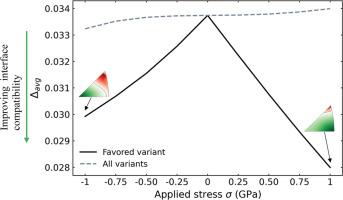当前位置:
X-MOL 学术
›
Acta Mater.
›
论文详情
Our official English website, www.x-mol.net, welcomes your
feedback! (Note: you will need to create a separate account there.)
Interface compatibility and hysteresis in shape memory materials are affected by lattice distortions from applied stresses
Acta Materialia ( IF 8.3 ) Pub Date : 2024-11-04 , DOI: 10.1016/j.actamat.2024.120528 Eliana M. Feygin, Christopher A. Schuh
Acta Materialia ( IF 8.3 ) Pub Date : 2024-11-04 , DOI: 10.1016/j.actamat.2024.120528 Eliana M. Feygin, Christopher A. Schuh

|
Significant effort has been put into designing shape-memory materials that can survive many cycles without functional or structural fatigue. A component of the design process is the condition defining perfect interface compatibility between the austenite and martensite lattices (λ2 = 1). In this paper, we evaluate the traditional mathematical theories of martensite under applied stresses, which distort the lattice compatibility through elastic strains. In NiTi we find that elastic distortions resulting from applied stresses influence the interface compatibility to a degree of impacting the material's functional abilities. Combining our results with empirical relationships connecting interface compatibility to transformation hysteresis we show that the model matches reasonably to a number of experimental results in the literature in which hysteresis changes under applied loads. We also apply these theories to a shape-memory ceramic (zirconia), which suggests a large orientation-dependence and asymmetric behavior in tension and compression. In both systems, we find that variant selection plays a large role in whether interface compatibility will improve or worsen under stress.
中文翻译:

形状记忆材料的界面兼容性和滞后性受施加应力引起的晶格变形的影响
人们投入了大量精力来设计能够承受多次循环而不会出现功能或结构疲劳的形状记忆材料。设计过程的一个组成部分是定义奥氏体和马氏体晶格之间完美界面兼容性的条件 (λ2 = 1)。在本文中,我们评估了马氏体在外加应力下的传统数学理论,这些理论通过弹性应变扭曲了晶格相容性。在 NiTi 中,我们发现由施加的应力引起的弹性变形会影响界面兼容性,从而在一定程度上影响材料的功能能力。将我们的结果与将界面兼容性与转换滞后联系起来的经验关系相结合,我们表明该模型与文献中滞后在施加载荷下发生变化的许多实验结果合理匹配。我们还将这些理论应用于形状记忆陶瓷(氧化锆),这表明在拉伸和压缩方面存在很大的方向依赖性和不对称行为。在这两个系统中,我们发现变体选择在压力下界面兼容性是会提高还是恶化起着重要作用。
更新日期:2024-11-04
中文翻译:

形状记忆材料的界面兼容性和滞后性受施加应力引起的晶格变形的影响
人们投入了大量精力来设计能够承受多次循环而不会出现功能或结构疲劳的形状记忆材料。设计过程的一个组成部分是定义奥氏体和马氏体晶格之间完美界面兼容性的条件 (λ2 = 1)。在本文中,我们评估了马氏体在外加应力下的传统数学理论,这些理论通过弹性应变扭曲了晶格相容性。在 NiTi 中,我们发现由施加的应力引起的弹性变形会影响界面兼容性,从而在一定程度上影响材料的功能能力。将我们的结果与将界面兼容性与转换滞后联系起来的经验关系相结合,我们表明该模型与文献中滞后在施加载荷下发生变化的许多实验结果合理匹配。我们还将这些理论应用于形状记忆陶瓷(氧化锆),这表明在拉伸和压缩方面存在很大的方向依赖性和不对称行为。在这两个系统中,我们发现变体选择在压力下界面兼容性是会提高还是恶化起着重要作用。


















































 京公网安备 11010802027423号
京公网安备 11010802027423号